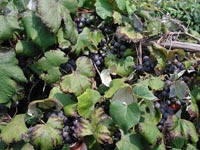Resource Library
Plant of the Week: Grape, Concord
The University of Arkansas System Division of Agriculture does not promote, support or recommend plants featured in "Plant of the Week." Please consult your local Extension office for plants suitable for your region.
Plant of the Week
Concord Grape
Latin: Vitis labrusca ‘Concord’

Grape growing had a slow start in the New World. European grapes derived from selections of Vitis vinifera that were susceptible to cold in the northern climates and susceptible to disease in the South. European grapes did find a niche in California, but vineyards were not significant there until late 1800’ s.
But by lucky happenstance a resident of Concord, Massachusetts named Ephriam W. Bull (1805-1895) raised a grape seedling in his garden that tolerated the vagaries of the American climate. Bull planted a few native fox grapes, Vitis labrusca, for decoration around his new home about 1840. After raising seedlings from two generations of these plants he selected a form with large fruit he named ‘Concord.’
The Concord grape leaves a lot to be desired by modern standards, but it is tough and dependable. The nickel size purple grapes are thick skinned, heavily seeded and with a sweet but strong grape flavor. By the end of the 19th century it became the most commonly planted grape in the nation and is given credit as the first really successful grape in the United States.
The Arkansas connection to the Concord grape involves a bad land deal. Plantation owners in the South during the 1890’s had chronic labor problems as people abandoned farm life and began to relocate to industrial centers in the north and east. Sharecropping solved some of the problems, but some large landowners worked deals to import immigrant workers.
In 1895 and 1896 a land developer named Austin Corbin (1827 - 1896) brought immigrant labor to land he owned in Sunnyside, AR. Located on the south end of the oxbow lake in Chico County, this hamlet was the destination of the 200 families from around Genoa, Italy. Cotton was the principle crop in this swampland. The hill country farmers who raised mainly fruit crops and grew grapes found themselves in a hostile environment growing a crop they knew nothing about.
Corbin was what Southerners would lovingly refer to as a carpetbagger - a banker turned railroad man who made most of his fortune running Long Island railroads. Under the agreement with Corbin’s company, the immigrants could own their land free and clear in as little as 21 years if they could make a go at farming.
But in 1896 Corbin died in a carriage accident. Corbin’s death, the failure of the dredging project he had started on the swampland, and a malaria epidemic that killed 100 people caused the Sunnyside project to fall apart.
Father Pietro Bandini, a Catholic priest in New York, learned of the plight of the immigrants and stepped in to help. In 1896 he arranged for the purchase of 80 acres of land a few miles west of Springdale and moved 40 families to the new settlement, which was named Tontitown, in honor of the 17th century Italian soldier-explorer who traveled swamps of the region.
The farmers quickly discovered that grapes grew well in northwest Arkansas and began establishing vineyards of Concord and hardy forms of wine grapes. In mid August of each year the community celebrates its Concord Grape Festival, the first being held in 1908. The queen selected to reign over the festivities is rightly dubbed Miss Concordia. Residents of the area endure long lines in the hot August sun to feast on the homemade pasta and fried chicken prepared by the legendary cooks of the community.
Concord juice can be made into a wine of the rotgut type, but its main claim to fame has always been for grape juice and jelly. In 1922 Welch Foods learned of the Concords being grown in the area and established a juice plant in Springdale. Until 1992, when the company sold the local plant, area farmers grew Concords under contract with Welch’s. The juice plant is now owned by Pappas Foods who sells grape and other fruit juice blends.
By: Gerald Klingaman, retired
Extension Horticulturist - Ornamentals
Extension News - September 13, 2002
The University of Arkansas System Division of Agriculture does not maintain lists of retail outlets where these plants can be purchased. Please check your local nursery or other retail outlets to ask about the availability of these plants for your growing area.